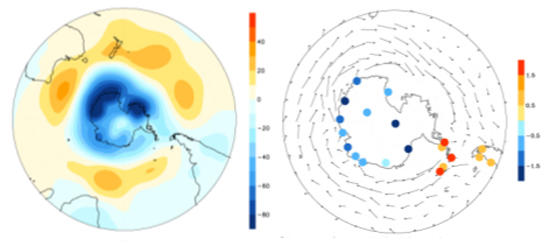Stratosphere-Troposphere Dynamical Coupling
Stratospheric changes are linked to tropospheric variability. Tropospheric variability in turn acts as a forcing mechanism for the stratosphere. Hence, future changes in tropospheric variability are expected to influence stratospheric dynamics and temperature. In the other direction, stratospheric changes directly impact the troposphere. Changes in the chemical composition of the stratosphere lead to significant changes of the radiative forcing at the tropopause. For example, the observed decrease of stratospheric O3 has been shown to change the radiative forcing of climate comparable in magnitude to other trace gases (e.g., Chapter 5 in WMO, 2007).
Further, statistical analysis of long-term observations revealed a link between the strength of the stratospheric polar vortex and the dominant modes of tropospheric variability, like the Northern or Southern Annular Modes (NAM, SAM). During the recent decades the tropospheric circumpolar flow increased over Antarctica in summer, associated with a warming of the Antarctic Peninsula and a cooling over the Antarctic plateau (Figure 3). It was argued that this trend towards a high SAM index was related to the intensification of the stratospheric polar vortex which was due to heterogeneous ozone depletion (Thompson and Solomon, 2002).
Variations of the NAM are associated with weather anomalies over the continents. The dynamical processes by which the tropospheric circulation responds to changes in the stratosphere are however not well understood (e.g., Chapter 5 in WMO, 2007). Hence, any future changes in stratospheric GHG concentrations and composition that influence the intensity of the stratospheric polar vortex have the potential to affect surface climate (e.g., Chapter 5 in WMO, 2007).

Figure 3: (in m, left panel) and near-surface temperature (in K) and winds (right panel). 22-year linear trends in 500 hPa geopotential and 925 hPa winds (1979-2000) and 32-year linear trends in surface temperature (1969-2000), averaged over December to May (Thompson and Solomon, 2002). (Figure taken from WMO, 2007.)
Improved climate predictions thus require the application of climate models that are able to simulate a) changes in the stratosphere, b) the vertical coupling between the stratosphere, the troposphere, and the oceans, and c) the interaction between chemical processes and dynamics. Such Chemistry-Climate Models (CCMs) of the atmosphere have been used in a first attempt to assess the future evolution of the stratospheric O3 layer (e.g., Chapter 6 in WMO, 2007). However, albeit the models agree in a future cooling of the lower stratosphere, they display a considerable spread in the simulated temperature evolution of the past four decades. Future projections of O3 and other constituents are highly uncertain. Simulations with coupled ocean-atmosphere CCMs do not yet exist.

